Once you’ve grasped the basics of Ohm’s Law and simple circuit elements, it’s time to elevate your circuit analysis skills with Kirchhoff’s Voltage Law (KVL) — a cornerstone of electrical engineering theory. While the concept may appear simple on the surface, its true power lies in its application to multi-loop circuits, complex components, and system-level design.
This guide dives deeper into the practical and analytical use of KVL for intermediate-level learners aiming to advance their understanding of DC and AC circuits.
1. What KVL Really Tells Us
At its core, Kirchhoff’s Voltage Law is derived from the conservation of energy in an electrical loop. As you travel around a closed path in a circuit, the algebraic sum of voltage rises and drops must equal zero.

This means that no voltage is ever lost or created spontaneously. All supplied electrical energy must be accounted for across the passive and active elements in the loop.
2. Voltage Polarity and Sign Convention
In intermediate analysis, a crucial detail is correctly assigning voltage polarities and respecting loop direction.
When traversing a component:
- If you enter through the positive terminal, the voltage is considered a drop (−V).
- If you enter through the negative terminal, it is a gain (+V).
When applying KVL, consistency is key. The direction of the loop and the orientation of components determine how you set up your equation.
3. Applying KVL to Multi-Loop Circuits
Consider a two-loop circuit with a shared resistor. To analyze this system, we define loop currents I1 and I2 and apply KVL to each loop individually. Shared components must reflect the net current, considering direction.
For example, if both currents flow through a shared resistor in opposite directions:

You must carefully identify each component’s contribution to the voltage drops/gains.
4. Example: Two-Loop Circuit with Shared Resistor
Imagine this setup:
- Left loop: 12V battery, 2Ω resistor, shared 1Ω resistor
- Right loop: 9V battery, 3Ω resistor, shared 1Ω resistor

5. KVL in Circuits with Reactive Components
In AC circuits, you’ll frequently deal with impedance rather than just resistance. Each component introduces a complex voltage drop:

A KVL equation around an AC loop might look like:

Here, KVL still applies — but with phasor voltages and complex impedance (Z).
6. Using KVL with Mesh Analysis
In structured circuit analysis, KVL forms the foundation of mesh analysis — a technique where:
- You assign a current to each independent loop.
- Apply KVL to each mesh.
- Solve the resulting system of equations.
This approach is efficient for planar circuits and scales well with software tools like SPICE or MATLAB.
7. Common Mistakes Intermediate Learners Make
- Misinterpreting polarities: Always label component polarities before writing equations.
- Loop direction inconsistency: Changing direction mid-calculation leads to sign errors.
- Forgetting mutual impedance: In AC systems with coupled inductors, mutual inductance affects voltage.
8. Practical Applications of KVL
KVL is applied in:
- Designing power supplies and converters
- Analyzing operational amplifier feedback loops
- Modeling signal paths in analog and RF circuits
- Electrical safety systems (ground fault detection)
- Control systems and robotics where feedback voltages matter
In short, it’s the analytical backbone of any design involving electrical energy.
9. Tips to Improve Your KVL Skills
- Always draw clear circuit diagrams.
- Use color-coded voltages and currents to avoid confusion.
- Start from a known reference node and mark voltage polarities.
- Double-check units and solve equations symbolically before plugging in numbers.
For digital learners, simulation software (LTspice, Multisim) is a great way to test KVL logic dynamically.
10. Final Thoughts: KVL Is More Powerful Than You Think
While often introduced as a basic rule, Kirchhoff’s Voltage Law scales up to analyze complex, real-world systems. From power grids to microcontrollers, the law enables engineers to model, test, and debug with mathematical precision.
As you progress, your ability to apply KVL confidently in both DC and AC circuits will mark a significant step forward in mastering circuit theory.

Leave a Reply